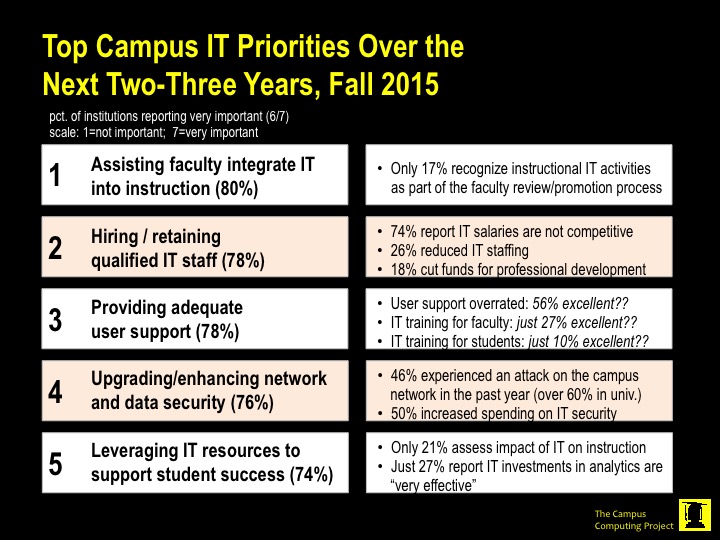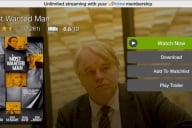You have /5 articles left.
Sign up for a free account or log in.
Welcome back. Happy 2016 to all.
In addition to the new term, new courses, and recurring committee work, January traditionally marks the beginning of the “heavy lifting” in the academic hiring, review, and promotion cycle. HR officers will compile and departmental committees will review the scholarly portfolios of those who seek academic appointments or hope to advance within and up the academic ranks.
Across all sectors and segments, most colleges and universities loudly and proudly proclaim the institutional commitment to the innovative use of technology in online and on-campus instruction. And in October, the Campus Computing Project reported that four-fifths of the CIOs and senior IT officers, who represent 417 two- and four-year colleges and universities, identified assisting faculty with the instructional integration of information technology as their “top institutional IT priority” over the next two-three years.”

Perhaps not surprisingly, the faculty and department chairs who sit on hiring, review, and promotion committees don't always share the concerns and priorities of the campus IT leadership.
Four decades into the “continuing” technology revolution in higher education, most institutions still ignore the instructional IT activities of individual faculty members who would like their efforts to make innovative and effective use of IT resources in instruction considered as part of their scholarly portfolio in the review and promotion process.
Consider, for example, the trend data on “review and promotion” from the Campus Computing Survey. Despite the rising role of technology in instruction over the past four decades, the vast majority of American colleges and universities have not expanded the faculty review and promotion process to include the role of information technology. Admittedly, the little good news in the table below is that in many sectors, the proportion of institutions that have expanded the review and promotion criteria to include technology has up dramatically, save for private research universities and private BA/MA institutions, where the numbers remain largely the same as they were in 1997. But even with the gains, the numbers in all sectors remain very low.
.jpg)
Moreover, even as many institutions support instructional innovation with grants to help faculty redesign courses, or to create simulations or other IT-based course and learning experiences, too few institutions have expanded the traditional review and promotion algorithm to include technology as an appropriate and valued activity in the hiring, review, and promotion portfolio and process.
Concurrently, too few institutions assess their efforts and investments in IT and instructional innovation: data from Campus Computing reveal that just of fifth of colleges and universities have a formal program to assess the impact IT on instruction and learning outcomes.
The issue of recognition and reward remains one of the most daunting for faculty across all ranks. This is particularly true for junior (tenure-track) faculty who may be expected to carry additional instructional burdens or lead on technology innovation – often without recognition.
The irony and impact of these data are daunting. The Campus Computing Survey data provide clear evidence that despite the proclamations of presidents, provosts, and board chairs about how “Acme College” has made significant investments to leverage information technology to enhance instruction, the operational decisions about tenure and promotion truly focus on the preferences and priorities of senior faculty and department chairs. And these decisions really depend on whether or not the departmental leadership and members of review committees will recognize and support the technology efforts and activities of faculty into and through the review and promotion process.
Too, the these data reveal that the operational decisions about promotion and tenure (still) fail to support an expansive version of scholarship – widely hailed but seldom implemented – proposed in 1990 by Ernest Boyer, former Chancellor of the SUNY System and the former president of the Carnegie Foundation for the Advancement of Teaching. In Scholarship Reconsidered, Boyer advocated for a view of scholarship went beyond traditional research to include the scholarship of teaching and learning, which today would include the scholarship of technology in instruction: a public sharing of efforts to bring technology resources into the teaching and learning experience coupled with an individual and institutional commitment to evaluate those efforts.
It is time to advocate for an expansive view of scholarship that values technology as part of the portfolio brought forward for review and promotion.
If institutional officials – including senior campus IT leaders – are truly committed to advancing the innovative role of technology in instruction, then senior faculty, department chairs, deans, and provosts will have to stand up and stand with the faculty who are doing (or want to try) this work so that their efforts are acknowledged as credible, scholarly, and worthy.
Follow me on Twitter: @digitaltweed






